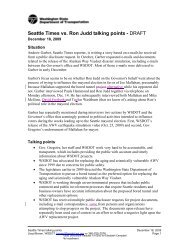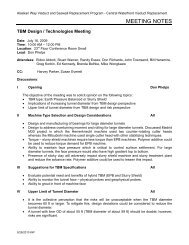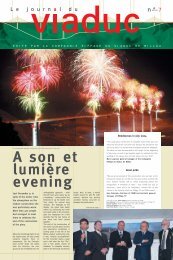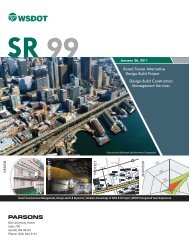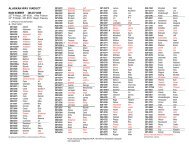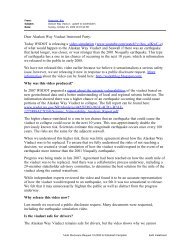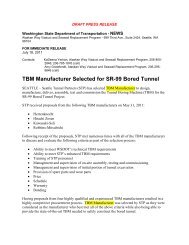SR99 Bored Tunnel-Assessment of Settlement Impacts ... - SCATnow
SR99 Bored Tunnel-Assessment of Settlement Impacts ... - SCATnow
SR99 Bored Tunnel-Assessment of Settlement Impacts ... - SCATnow
You also want an ePaper? Increase the reach of your titles
YUMPU automatically turns print PDFs into web optimized ePapers that Google loves.
3.0 Tilt Meter Monitoring3.1 Goals3.2 ImplementationTilt meters give continuous information on the tilt <strong>of</strong> an object. Their output is acontinuous voltage proportional to the tilt (or inclination) at the sensor location.• Economical determination <strong>of</strong> the tilt or change in slope <strong>of</strong> structuralcomponents.• Strategic sensor placements such that tilt measurements for critical buildingelements indicate no damage has occurred or indicate the severity <strong>of</strong> thedistortions.• Meter placement early in the project to get a baseline; if necessary, add someadditional sensors if settlements are higher than anticipated.• Install wiring for the output to be observable remotely. However, wirelesstechniques are in development and wiring may not be required for thisproject.• Typical accuracy <strong>of</strong> 1/1000 degree (1/100 inch per 5-story height).Find locations that describe the severity <strong>of</strong> building distortions (in other words,install the meter where movement is most likely to occur). Determine if singledirection tilt or biaxial tilt is needed. Measurement <strong>of</strong> leaning walls is simple; thesensor can be placed on a metal bracket fastened to the wall. To determinesettlements in beam-column systems (where columns remain nearly vertical), placethe sensors on the beams near the center <strong>of</strong> the span. For measuring sheardeformations in walls fasten beam type members that are spanning the wall and placetilt meters on this added beam type members.Each sensor requires a cable connected to a centrally located data acquisition pointto power the sensor and to provide for reading the signal. Most tilt sensors aretypically placed in the basement; however, measuring tilt both on the lowest floorand the top floor <strong>of</strong> a high-rise building would require expensive placement <strong>of</strong> longcables. Therefore, if tilt measurements are required at the top <strong>of</strong> a high-rise, it wouldbe more economical to add a second acquisition point at the top with an internetconnection, resulting in shorter cables.A major cost is the cable placement, especially if sensors are reused. Wirelesssystems are continuously being enhanced, so it may be feasible to use wirelessmethods. If sensors are reused ten times, wireless would probably be more costThe Alaskan Way Viaduct & Seawall Replacement Program March 2010Proposed SR 99 <strong>Bored</strong> <strong>Tunnel</strong> - <strong>Assessment</strong> <strong>of</strong> <strong>Settlement</strong> <strong>Impacts</strong> to Buildings E-5Public Disclosure Request 11-0123 for Elizabeth Campbell - 2nd installment




